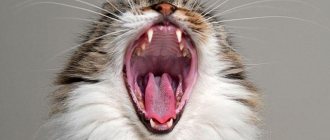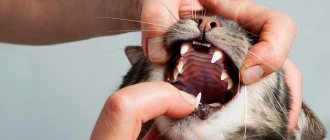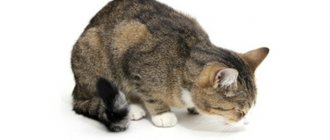It so happens that cats suffer from approximately the same diseases as people. They often face the problem of tartar deposits. What is tartar? These are calcareous deposits with a fairly stable structure that grow quickly and give the tooth a yellow or dark brown color.
Reasons for education
In veterinary medicine, there are several reasons that influence the formation of tartar:
- Improperly balanced cat nutrition. The lack of natural food leads to the formation of microorganisms, which, when interacting with saliva, lead to the formation of deposits.
- Incorrectly formed bite.
- Metabolic disorders in the cat’s body lead to improper salt metabolism, resulting in the growth of tartar.
- Insufficient oral care.
- The presence of inflammation of the gums.
Treatment of alveolitis in STOMA clinics
Surgeons at STOMA clinics are required to examine patients and give recommendations on how to care for the hole formed after tooth extraction. If problems arise after extraction, the patient can always call the clinic and clarify whether inflammation has really begun and what to do to reduce pain.
At any time after removal, the patient can contact our clinics. The attending surgeon will examine him and prescribe appropriate therapy.
Feel free to call us at any time and consult about your condition. The sooner we start treating alveolitis, the lower the risk of complications.
Types of Tartar
Tartar, as a rule, forms in places where saliva is washed; incisors and molars are susceptible to it. Sometimes these formations cover not one, but several teeth in a row. Dental stones are divided according to their location. They are:
- Supragingival. This type of deposit is located above the gum. It can be noticed during examination of the animal's oral cavity.
- Subgingival. These deposits are located on the root of the tooth, under the gum. It is impossible to notice it during inspection. It promotes the formation of places in the cat’s gums where bacteria accumulate. As a result, loosening and loss of the tooth occurs.
What do cat teeth and gums normally look like?
Like most mammals, cats have 2 sets of teeth - milk and permanent. Kittens are born toothless, but after a few days they begin to cut their first milk teeth.
The change from a temporary set to a permanent one begins 6–8 weeks after birth. This is a gradual process, so for most owners it goes unnoticed, given the small size of the teeth. By 8 months, all baby teeth should be replaced by molars. Since cat saliva contains the enzyme lysozyme, which has an antibacterial effect, the change occurs painlessly.
An adult cat normally has 30 teeth: 16 in the upper jaw and 14 in the lower jaw. There is a congenital feature - oligodontia, which is inherited, in which the dental set is incomplete.
The structure of the teeth is determined by the diet of cats. Cats are predatory animals; they use their teeth to hold prey and tear meat. Description of the dental kit:
- Incisors. Small teeth that are located in the front of both jaws, 6 pieces on each. Unlike herbivores and omnivores, the cat does not bite off food with them; they serve to hold pieces of food.
- Fangs. The longest and sharpest teeth, 2 fangs on both sides on each jaw. They have the deepest root canals. Designed to kill prey - with them the cat bites through the area near the victim's spine, damaging the spinal cord, and with them it tears off pieces of food.
- Premolars. The 6 upper and 4 lower molars are designed for grinding dense foods, such as meat.
- Molars. 4 molars on both jaws. Also used for chewing food.
Symptoms
Even the most inexperienced owner will understand that the cat has developed tartar. Most common symptoms:
- Extremely unpleasant odor from the mouth.
- Growths formed on the surface of teeth.
- Inflammatory processes of the gums.
- The cat is extremely irritated while eating, shaking its head and growling.
- Profuse salivation.
- Loosening and loss of teeth.
- The cat regularly rubs its cheek against something.
- Yellow or dark brown plaque at the base of the tooth.
- Swelling of the oral mucosa.
- Swollen eyes.
Diagnostics
If any of the listed symptoms are detected, you must immediately contact a veterinarian in order to accurately make a diagnosis and begin qualified treatment. Diagnosis of the disease includes only a visual examination by a veterinarian or dentist. As a rule, after the examination we are talking about urgent treatment of the pathological process.
Diagnostic methods
To make the correct diagnosis
For your “yellowed” pet, the veterinarian will definitely interview you in detail about the cat’s condition, nutrition, and behavior. Then he will prescribe laboratory tests such as blood biochemistry, blood sugar, coagulogram, general blood test, tests for viral infections, toxoplasmosis, parasitic infestations, and urinalysis. An ultrasound and x-ray may be necessary. Sometimes a liver biopsy is required. Thanks to these tests, the doctor will reveal where the “culprit” of jaundice is hiding and determine the disease. Having made a prompt diagnosis, a veterinarian will most likely be able to cure jaundice in a cat.
How does the removal take place?
Tartar removal is a fairly painful procedure that lasts from 30 to 60 minutes. As a rule, cleaning is carried out in three stages; only compliance with all stages will help to efficiently clean the resulting growths on the teeth. If the procedure was performed poorly or without any point, then the stone will form again, and the animal will have to go through this unpleasant procedure again, which includes:
- Mechanical removal of large stones using dental instruments.
- Ultrasonic cleaning is performed to remove small stones.
- Grinding and polishing of teeth is done using special pastes.
If the animal is old or sick and cannot withstand general anesthesia, then the veterinarian develops a step-by-step treatment of the growth, which is carried out without the use of anesthesia, under the influence of painkillers. In this case, the stone is removed gradually, over several visits to the clinic.
Is it possible to remove tartar at home?
Tartar treatment can only be done in a clinic. Removal at home is impossible, since this is a rather complex procedure, which is done mainly under anesthesia in a veterinary clinic.
Under no circumstances should you remove tartar at home, as this can cause severe pain to your cat and damage its health.
How to prepare a cat for surgery
If, after an examination, the veterinarian prescribed surgery using general anesthesia, the owner must prepare the pet for this unpleasant event at home:
- The young animal must prepare by fasting, which lasts from 12 to 24 hours.
- Elderly cats, or those pets that have any health problems, should be prepared before surgery using laboratory tests and a careful examination by a veterinarian.
Caring for your cat after removal
After treatment has been carried out, the cat will need careful care, which includes:
- Painkillers that can be given at home.
- Food should be semi-liquid, gentle and lukewarm.
Classification
Depending on the nature of the healing of the hole, dentists distinguish several main forms of dental alveolitis:
- Serous. The initial stage of the disease usually appears 2–3 days after tooth extraction. This form is characterized by continuous pain that worsens while eating. Although the patient does not yet complain of feeling unwell, his lymph nodes are not enlarged, but he already feels that the disease is progressing.
- Purulent. If the serous form of alveolitis is not treated, the disease turns into a purulent form. Most often it is diagnosed 6–7 days after tooth extraction. The painful sensations can no longer be ignored, the pain intensifies, radiating to the ear or temple. Exploring the affected area also causes severe pain. Purulent alveolitis is characterized by a dirty gray coating inside the socket, significant swelling around the wound, thickened alveolar process and other problems. The patient's general health deteriorates significantly. Lymph nodes enlarge and become painful on palpation. Often the patient cannot even eat or open his mouth.
- Hypertrophic. At this stage, the symptoms of the disease subside. The patient notes a decrease in body temperature, improved well-being and decreased pain. However, at the hypertrophic stage, dangerous tissue proliferation occurs, which is clearly visible upon examination. When touched, pus is released from the inflamed area, and the mucous membrane acquires a bluish tint.
Ask a Question
Prevention
To prevent your cat from having a similar problem, it is necessary to prevent tartar at home, which includes simple rules:
- Regular brushing of your cat's teeth will help avoid these troubles. Moreover, you need to start teaching your kitten about oral hygiene, because they get used to it more easily than adult cats.
- A balanced diet also prevents problems with stone formation. Dry food has proven itself very well; it contains dietary fiber, which has a beneficial effect on the surface of the teeth and provides additional cleaning.
- Currently, there are commercially available foods that contain polyphosphate, which creates a protective film on the teeth that protects them from plaque.
- Taking vitamins that contribute to the overall health of your pet, and the oral cavity is no exception.
- Gastrointestinal diseases lead to an imbalance in the alkaline balance in the cat’s mouth, so regular medical examinations are necessary to monitor the pet’s health.
- Regular dental examinations by a veterinarian are recommended as a preventive measure for various oral diseases.
Dry foods are not a panacea for the formation of tartar; they provide good protection against plaque formation only if oral hygiene is maintained.
At-risk groups
- Tartar in cats usually forms when it reaches an age over five years, especially if the animal’s oral cavity has not been properly cared for. Recently, this problem has also begun to occur in young animals; there is a correlation with the animal’s unbalanced food.
- In veterinary medicine, there is evidence that the most common breeds, such as Persian, Siamese, Scottish, are most predisposed to this disease. This is because sometimes unskilled breeders weaken the gene pool of these sought-after cats.
- Backyard cats living in rural areas and eating natural food are less susceptible to this disease. They have stronger immunity than their elite relatives.
By carefully caring for your cat, you can avoid problems such as the formation of tartar in your pet. If such a problem affects your pet, then the help of a qualified specialist is necessary.
We recommend reading: How to properly brush your cat’s teeth at home?
Treatment of alveolitis
When the socket becomes inflamed, the main thing is to eliminate the source of infection, prevent the development of inflammation and preserve the dentition. In order to alleviate the patient’s condition, the dentist uses the following therapy methods:
- Mechanical cleansing of the hole, washing out purulent residues with a solution of nitrofural or hydrogen peroxide.
- Anesthesia of the hole. The pain syndrome is relieved with the help of local applications with anesthetics and analgesics. To do this, the doctor applies the lotion for half an hour and then removes it to prevent the proliferation of microbes in the area. The dentist will advise the patient to repeat the procedure several times a day. Taking painkillers orally is not recommended.
- Taking antibiotics. In the presence of concomitant diseases, alveolitis is treated with antibiotics.
With the right approach, the signs of alveolitis subside 2-3 days after the start of treatment. If therapy was not started on time, residual pain may drag on for 2–3 weeks.
With the permission of the dentist, additional treatment of alveolitis with folk remedies is possible:
- Sage rinses. To prepare the solution, brew a large spoonful of dry sage in 250 ml of boiling water, leave the mixture for an hour, wrapping the container in a towel. After this, the liquid should be filtered and used for rinsing.
- Gargling with chamomile flowers. To prepare the composition, brew a large spoonful of chamomile flowers in a glass of water for 15 minutes, insulating the container with a towel. The infusion should be strained and rinsed your mouth up to 12 times a day.
- Poplar buds. To prepare, take half a glass of buds, pour into a glass container and pour in 500 ml of vodka. The product should be infused for 10 days in the dark and cool, then filtered, soaked in cotton swabs and applied to the inflamed area.
- A soda rinse solution can also be an effective addition in the treatment of alveolitis. You should take a large spoonful of powder in a glass of warm water or mix soda with water to obtain a paste-like mass, which then needs to be used to treat the hole.
- Burdock leaves. To prepare a medicinal decoction of burdock leaves, you need to pour 20 grams of raw material with 2 glasses of water, and then simmer the mixture over low heat for about 40 minutes. The resulting solution should be cooled and filtered, and then used for rinsing.
- Aspen bark. Pour 1 tablespoon of crushed aspen bark into one glass of boiling water. It is important to leave the solution in an airtight container for 3 hours, and then use 100 ml of strained warm liquid at least 3 times a day.
- Anise infusion. To prepare the infusion, pour 1 tablespoon of anise into 200 ml of boiling water, and then keep in a thermos for 50 minutes. The liquid should be filtered and used to rinse 3 times a day.
Gingivitis in cats
This disease means inflammation, bleeding of the gums, the appearance of cracks and ulcers. It is often accompanied by excessive salivation and a repulsive odor from the mouth.
Therapy involves removing plaque and stones from teeth. For this purpose, special products are used - ointments and gels, which are applied to the surface of the gums (Zubastic, Metrogyl Denta, Dentavedin).
Prevention of gingivitis involves regular care - brushing teeth using cat toothbrushes and toothpastes. It is also useful to give your pet dry food to prevent the formation of deposits on the teeth.











